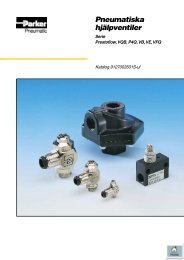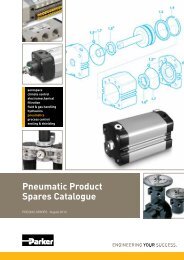Atlas Copco air motors - IAG
Atlas Copco air motors - IAG
Atlas Copco air motors - IAG
You also want an ePaper? Increase the reach of your titles
YUMPU automatically turns print PDFs into web optimized ePapers that Google loves.
Torque<br />
[100%]<br />
100<br />
Introducing the <strong>air</strong><br />
motor<br />
The <strong>air</strong> motor is one of the toughest and most<br />
versatile power units available to today´s<br />
design engineer. It is easy to control over a<br />
wide speed range, and it produces maximum<br />
torque where it is often most needed – at start<br />
up.<br />
The performance of an <strong>air</strong> motor is dependant on the inlet pressure.<br />
At a constant inlet pressure, ungoverned <strong>air</strong> <strong>motors</strong> exhibit the characteristic<br />
linear output torque/speed relationship. Figure 1.<br />
However, by simply regulating the <strong>air</strong> supply, using the techniques<br />
of throttling or pressure regulation, the output of an <strong>air</strong> motor can<br />
be easily modified.<br />
The free speed and torque can be regulated down to 50% for an<br />
LZB <strong>air</strong> motor. The free speed for an LZL can be regulated down<br />
to 10% and the torque can be regulated down to 20%. The shaded<br />
areas in figure 2 illustrate this.<br />
50<br />
Torque<br />
[Nm]<br />
50 100<br />
Speed [100%]<br />
Torque<br />
[100%]<br />
100<br />
Speed [r/min]<br />
Figure 1<br />
10 50 100<br />
Speed [100%]<br />
LZB LZL<br />
6 ATLAS COPCO AIRMOTORS<br />
50<br />
20<br />
Figure 2<br />
It should be noted that all vane <strong>air</strong> <strong>motors</strong> produce a variable starting<br />
torque, due to the position of the vanes in the motor when it is<br />
started. The variation differs between motor types and must be<br />
checked on an individual basis.<br />
The power that an <strong>air</strong> motor produces is a function of torque and<br />
speed. All ungoverned <strong>air</strong> <strong>motors</strong> produce the same characteristic<br />
power curve, with maximum power occurring at around 50% of the<br />
free speed. The torque produced at this point is often referred to as<br />
”torque at maximum output.”<br />
The performance curves for an ungoverned <strong>air</strong> motor operating at a<br />
constant <strong>air</strong> pressure are illustrated in figure 3.<br />
Torque<br />
[Nm]<br />
Stall<br />
torque<br />
Min<br />
starting<br />
torque<br />
The use of gear units<br />
Torque<br />
Power<br />
Speed [r/min]<br />
Figure 3<br />
Air <strong>motors</strong> operate at high speed and, although they can be controlled<br />
over a wide speed range, the output characteristics are not<br />
always suitable for the application. To achieve the required output<br />
an appropriate gear unit can be selected. The ability to change the<br />
output by use of a gear unit is illustrated in figure 4.<br />
Torque<br />
[Nm]<br />
4:1<br />
2:1<br />
1:1, 2:1, 4:1 = gear ratios<br />
The planetary and helical gear units used by <strong>Atlas</strong> <strong>Copco</strong> have a<br />
high level of efficiency that can be assumed to be 100%. The<br />
power output remains virtually unchanged also when gears are<br />
used.<br />
Note. The above does not apply to worm drive gear units, which can<br />
have high frictional losses and, therefore, loss of power output.<br />
1:1<br />
Torque<br />
Power<br />
Speed [r/min]<br />
Figure 4




